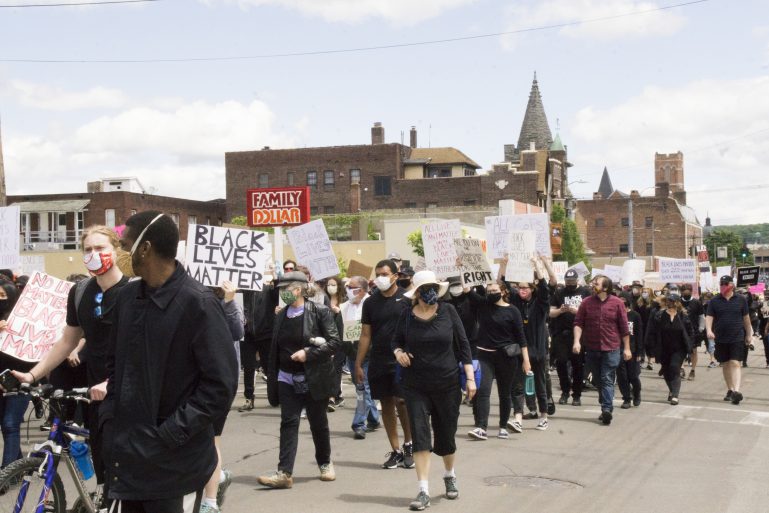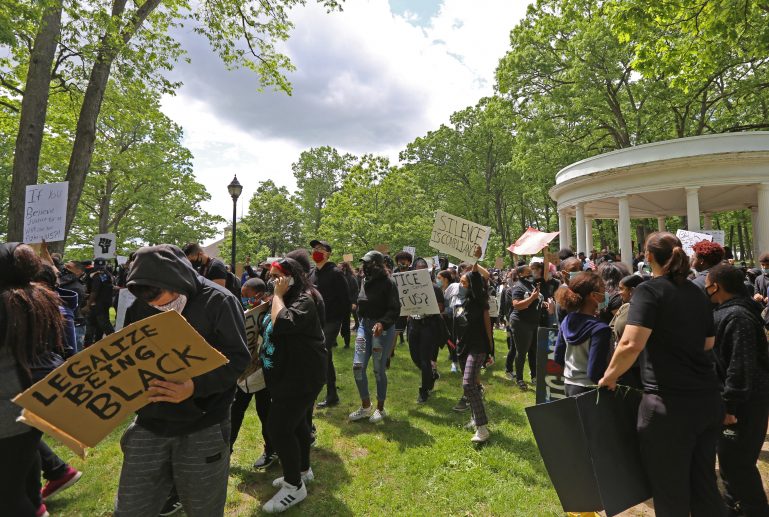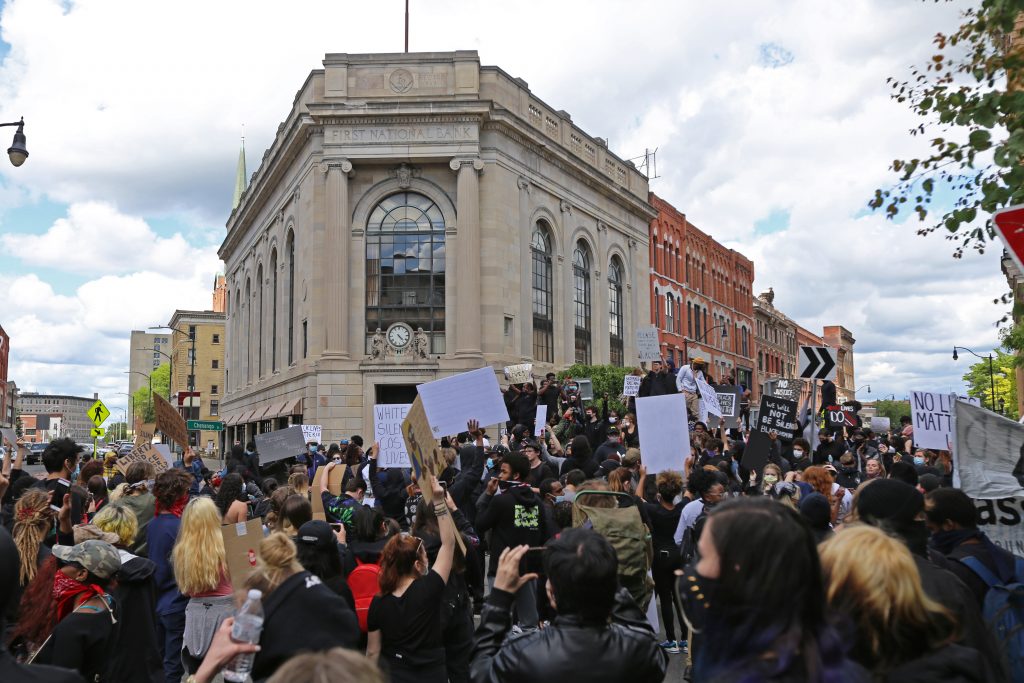On Sunday afternoon, hundreds of people marched in Downtown Binghamton to voice their frustration over the killing of George Floyd, 46, at the hands of a police officer in Minneapolis, Minnesota.
On May 25, Floyd, a black man, was caught on video as police officer Derek Chauvin, 44, knelt on his neck while Floyd repeatedly said, “I can’t breathe.” Floyd’s death drew parallels to the death of Eric Garner, a black man who died in 2014 of an asthma attack caused by a police officer’s chokehold while repeating those same words. Floyd’s death, along with the deaths of Ahmaud Arbery, 25, and Breonna Taylor, 26, earlier this year, sparked a nationwide movement against police brutality toward people of color.
The protest in Binghamton was organized by several Binghamton High School (BHS) students, including Melisha Jones, a 17-year-old junior at BHS. Progressive Leaders of Tomorrow (PLOT), a community organization that aims to empower and liberate marginalized members of society, played an active role as well. Nearly 1,000 people joined in solidarity with the movement, dressed in black and holding signs reading, “I can’t breathe,” “White silence is violence” and “No lives matter until black lives matter” among others.

Kimberly Gonzalez/News Editor
Near the end of the protest, there was a moment of silence for Floyd and all of the other victims of police brutality. This was the second protest of the day. In a tweet, Binghamton Mayor Rich David thanked the protesters for being peaceful.“Both protests in Binghamton have now concluded,” David wrote. “Thank you to our community members who this afternoon marched and exercised their First Amendment rights peacefully and without major incident.”
The string of protests nationwide turned into riots that looted and destroyed businesses in cities like Minneapolis. Some were worried the same would happen in Binghamton, but the only attempts at violence that occurred were instances of water bottles flung at police officers. The actions were quickly dismissed by organizers and protesters. Adeolu Ademoyo, 61, of Binghamton, said that he appreciated the peacefulness of the march as a whole.
“I like the peaceful nature of the protest,” Ademoyo said. “I am happy that I was able to quickly stop potential trouble when some of the participants taunted a group of police officers on Hawley Street when we got [to] them from Recreation Park.”
Brandy Henry, a junior majoring in biology, said the protest made her see she was not alone in her suffering.
“I started to feel really hopeless seeing people who look like me and my family members be subjected to violence that has no real purpose,” Henry wrote. “This has been an extremely painful time [and] that pain is eased slightly when you realize you’re not suffering alone. When George Floyd was murdered it was a feeling that was all too familiar.”
Henry said that the deaths of people of color at the hands of police have terrified her.
“[I felt] completely hopeless and afraid that one day someone I love will be a hashtag,” Henry wrote. “It’s such an overwhelming feeling. It was almost like I couldn’t breathe.”
Jysir Goldsmith, 17, of Binghamton, marched in order to make a difference in the community, he said.
“[The protest] made people realize how we feel and it brought strangers of all colors and nationalities together to commute to this Black Lives Matter protest,” Goldsmith said.
An anonymous Binghamton University sophomore majoring in political science said they attended the event and were glad it was peaceful.
“It was really powerful to have so many people of different backgrounds participate and show their support,” they said. “I do feel though that this is a first step of many and there is much more that needs to be done in terms of fighting inequality and racism. It isn’t just over with one march or protest.”
Ademoyo said he marched as a father, a Christian and a human being.
“I am a human being and blood runs in my veins,” Adeymoyo said. “I feel. I have empathy. I believe that the police murdered Mr. George Floyd and this murder is a pattern in our country in a historical sense. I reject murder, it is evil. I love my city, Binghamton. I do not want murder in Binghamton.”
Ademoyo said he respects young people marching for a change. Young adults and teenagers formed a majority of the protesters at Sunday’s event.
“I wanted to be right out there in solidarity with younger ones and among people, especially millennials who, this society, my generation, has shortchanged,” Ademoyo said.
Prior to the protest occurring, BU President Harvey Stenger made a B-Line statement on Saturday voicing his solidarity with those frustrated by the killing of Floyd and calling for justice.
“While the [BU] community stands together with the thousands engaged in peaceful protest of Mr. Floyd’s killing, we also call on those responding with violence to desist,” Stenger wrote.
Ariel Kachuro/Managing Editor
“We will not let their [Arbery, Floyd, Taylor and more] deaths be generalized as the struggles of [people of color] in America, because it is a statistical fact that no other races are murdered and targeted like black and Native American folks,” BSU wrote.
Additionally, BSU referred to BU’s response to the protests last fall where BU students protested against the unauthorized tabling of Turning Point USA (TPUSA), a national right-wing organization, and the arrival of Arthur Laffer, an economist and former adviser to former President Ronald Reagan and President Donald Trump. At the protests, students voiced their frustration with the Binghamton’s New York State University Police (UPD), claiming that its officers performed several injustices to students of color at BU.
“This statement comes at a surprise to the black students at [BU] because you failed to address anti-blackness, institutionalized racism and systemic violence displayed toward black students at the hands of [UPD] on our campus during the fall 2019 semester.”
After the protests ended, the Student Association (SA) sent out a statement on racial violence to honor Taylor, Arbery and Floyd while also informing students on how to safely organize protests.
“Racism should not have a place in our society and we should all work to ensure it does not have one in Binghamton or our country,” the SA Executive Board wrote. “As the leaders of a student government that represents all students, we stand in solidarity with our marginalized communities to demand an end to these injustices.”
Nicole Sirju-Johnson, ‘99, director of the Multicultural Resource Center and interim chief diversity officer, added that students who choose to protest should take steps to ensure their safety and the safety of others.
“Remember that there are multiple ways to raise awareness about change by engaging your elected officials at the national, state and local levels,” Sirju-Johnson wrote. “Ensure you are registered to vote in upcoming elections. Practice self-care by engaging in dialogue with friends, loved ones and other professionals to unpack the energies that can plague our mental and emotional health at times of extreme frustration.”



